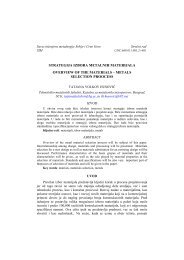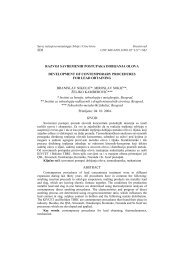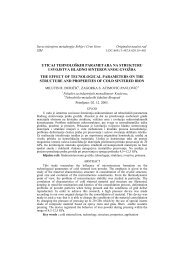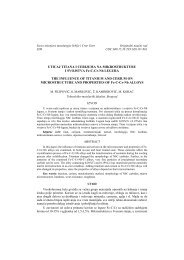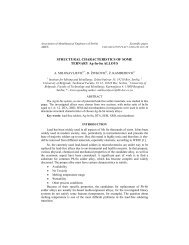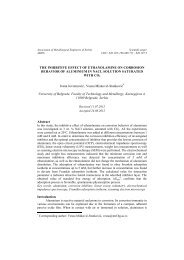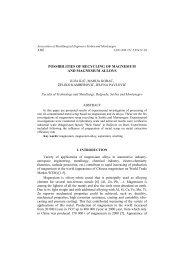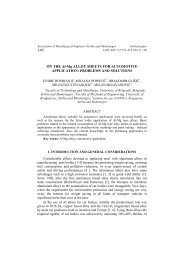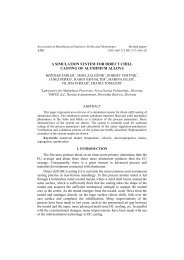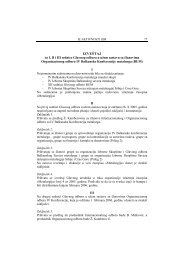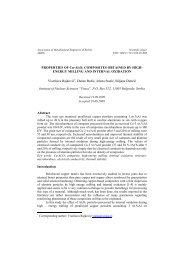PROCESSING AND PROPERTIES OF SILVER-METAL OXIDE ...
PROCESSING AND PROPERTIES OF SILVER-METAL OXIDE ...
PROCESSING AND PROPERTIES OF SILVER-METAL OXIDE ...
Create successful ePaper yourself
Turn your PDF publications into a flip-book with our unique Google optimized e-Paper software.
Association of Metallurgical Engineers of Serbia<br />
AMES<br />
Scientific paper<br />
UDC: 620.22:621.3 ; 621.38.032<br />
<strong>PROCESSING</strong> <strong>AND</strong> <strong>PROPERTIES</strong> <strong>OF</strong> <strong>SILVER</strong>-<strong>METAL</strong> <strong>OXIDE</strong><br />
ELECTRICAL CONTACT MATERIALS<br />
Nadežda M. Talijan 1 , Vladan R. Ćosović 1* , Aleksandar R. Ćosović 2 ,<br />
Dragana T. Živković 3<br />
1 University of Belgrade, Institute of Chemistry, Technology and Metallurgy,<br />
Njegoševa 12, 11000 Belgrade, Serbia<br />
2 Institute for Technology of Nuclear and Other Mineral Raw Materials,<br />
Franse d’ Eperea 86, 11000 Belgrade, Serbia<br />
3 Technical Faculty in Bor, University of Belgrade,<br />
Vojske Jugoslavije 12, 19210 Bor, Serbia<br />
Received 19.11.2012<br />
Accepted 06.12.2012<br />
Abstract<br />
The presented study gives a brief overview of the experimental results of investigations<br />
of different production technologies of silver-metal oxide electrical contact materials in<br />
relation: processing method - properties. The two most common routes of production,<br />
i.e. internal oxidation/ingot metallurgy and powder metallurgy are demonstrated on the<br />
example of Ag-CdO and Ag-ZnO materials. For illustration of alternative processing<br />
routes that provide higher dispersion of metal-oxide particles in silver matrix more<br />
environmentally friendly Ag-SnO2 contact materials are used. Processing of electrical<br />
contact materials by mechanical mixing of starting powders in high energy ball mill is<br />
presented. The obtained experimental results of application of different methods of<br />
introduction of SnO2 nanoparticles in the silver matrix such as conventional powder<br />
metallurgy mixing and template method are given and discussed in terms of their<br />
influence on microstructure and physical properties (density, hardness and electrical<br />
conductivity) of the prepared Ag-SnO2 electrical contact materials.<br />
Keywords: silver-metal oxide contacts, processing, properties, oxide nanoparticles<br />
Introduction<br />
The silver based electrical contact materials are widely used by electrical and<br />
electronics industry representing a significant group of functional materials [1]. Basic<br />
properties required for these materials are high electrical and thermal conductivity, high<br />
resistance to arcing, high welding resistance, low contact resistance, high hardness and<br />
* Corresponding author: Vladan Ćosović, vlada@tmf.bg.ac.rs
260 Metall. Mater. Eng. Vol 18 (4) 2012 p. 259-272<br />
strength. For several decades Ag-CdO has been the material of choice for application in<br />
wide range of switching devices [2]. This is due to its superior anti welding properties<br />
and wear resistance, suitable hardness that enables good machineability and high<br />
electrical conductivity. Taking into consideration toxic nature of cadmium and strict<br />
environmental legislation (RoHS, WEEE) numerous materials have been investigated as<br />
a possible more environmentally friendly substitutes [3]. Among those, Ag-SnO2 and<br />
Ag-ZnO have emerged as the most promising candidates [4]. As both materials do not<br />
always offer the same performance as Ag-CdO various attempts were carried out to<br />
enhance their performance mainly by introduction of small amounts of different metal<br />
oxides (In2O3, CuO, Bi2O3 or WO3) [3-6]. The other important factor is dispersion of<br />
metal oxides in silver matrix as it is generally accepted that the performance of these<br />
materials can be improved by finer dispersion [7,8]. Considering that the oxide<br />
dispersion is directly related to the applied processing technique, a variety of production<br />
routes has been developed. The two dominant commercially used techniques are powder<br />
metallurgy and internal oxidation of silver alloys [9,10]. As both wet and dry mixing of<br />
powders reach the limit of applicability at particle sizes about 1-2 µm, in order to obtain<br />
homogenous microstructures containing fine metal oxide particles, internal oxidation,<br />
reactive milling or chemical precipitation are used. The internal oxidation route relies<br />
on ingot metallurgy processing to produce starting silver alloys by melting and casting.<br />
The prepared cast slabs are usually rolled with intermediate annealing and subsequently<br />
subjected to internal oxidation by heating in oxygen atmosphere.<br />
Further improvement in homogeneity and finer dispersion can be achieved by<br />
methods based on chemical precipitation such as dual-jet or more recently bio casting or<br />
polymer assisted inorganic composite formation methods.<br />
The presented study provides a brief overview of the experimental results of<br />
investigations of different production technologies and their influence on properties of<br />
silver based electrical contact materials, with emphasis on currently dominating Ag-<br />
SnO2 materials. The most commonly used internal oxidation/ingot metallurgy and<br />
powder metallurgy methods are illustrated on example of Ag-CdO, Ag-ZnO and<br />
nanocrystalline Ag-SnO2 materials. High energy ball milling route is utilized for<br />
preparation of homogenous Ag-SnO2 powder mixtures. The influence of metal oxide<br />
nanoparticles and method of their introduction into the silver matrix on uniformity of<br />
microstructure and physical properties, such as: density, hardness and electrical<br />
conductivity of Ag-SnO2 materials are also presented. In addition, some of the most<br />
common applications of the silver based electrical contact materials are discussed.<br />
Materials and Processing<br />
Internal oxidation/Ingot metallurgy<br />
The internal oxidation route (IO) relies on ingot metallurgy processing to<br />
produce starting silver alloys by melting and casting. Ag-Cd alloys with 9.5 mass % of<br />
Cd were synthesized by melting of pure Ag and Cd metals (99.90 mass %). The<br />
prepared cast slabs were firstly homogenized at 600 o C for 4 h in nitrogen atmosphere<br />
and subsequently plastically deformed with intermediate annealing at 600 o C. Internal<br />
oxidation of the investigated alloys was carried out in electro-resistive oven in air<br />
atmosphere under natural convection of air at 670 o C, 750 o C and 795 o C during 48 hours.<br />
Technological procedure of the internal oxidation route for production of Ag-<br />
CdO electrical contact materials is given in Fig. 1.
Talijan et al. - Processing and Properties of Silver-Metal Oxide Electrical Contact Materials 261<br />
Fig. 1 – Flowchart of the internal oxidation process of Ag-Cd alloys Graphical<br />
representation of the influence of temperature and time on thickness of the oxidized<br />
layer is given in Fig. 2.<br />
Thickness [mm]<br />
0,7<br />
0,6<br />
0,5<br />
0,4<br />
0,3<br />
0,2<br />
0,1<br />
0,0<br />
-0,1<br />
795 o C<br />
750 o C<br />
670 o C<br />
0 10 20 30 40 50<br />
Time [h]<br />
Fig. 2 - Dependence of thickness of oxidized layer of Ag-Cd alloys on temperature and<br />
duration of internal oxidation process<br />
The results presented in Fig. 2 demonstrate that at higher temperatures (795 o C)<br />
oxidation rate is higher. Hence, for the applied synthesis conditions temperature has the<br />
dominant influence on the process of internal oxidation.
262 Metall. Mater. Eng. Vol 18 (4) 2012 p. 259-272<br />
Microstructure of the prepared IO Ag-CdO electrical contact material is<br />
illustrated by the scanning electron microscopy (SEM) images given in Fig 3.<br />
a)<br />
b)<br />
Fig. 3 - Microstructure of the Ag-CdO prepared by internal oxidation process<br />
In the optimized process of oxidation high and homogenous dispersion of CdO in<br />
the silver matrix is obtained (Fig. 3). In order to provide good bond between the contact<br />
material and contact holder by soldering, about 25% of the total thickness of the<br />
electrical contact material is left unoxidized (Fig. 3b). More detailed information on<br />
influence of process parameters on oxidation kinetics is given in [10].
Talijan et al. - Processing and Properties of Silver-Metal Oxide Electrical Contact Materials 263<br />
Powder metallurgy<br />
Powder metallurgy method (PM) provides uniform microstructure, high electrical<br />
conductivity and gives possibility for quick and easy production of samples with a<br />
variety of chemical compositions i.e. possibility of production of silver based<br />
composites containing two or more metal oxides.<br />
Studied PM Ag-ZnO (90:10) electrical contact materials were produced from<br />
pure silver powder obtained by chemical synthesis route and very fine commercial ZnO<br />
(99.0%) powder produced by Sigma-Aldrich.<br />
The technological procedure included dry and wet homogenization of powder<br />
mixtures, pressing, sintering and additional mechanical treatment (forging) as illustrated<br />
in Fig. 4.<br />
Fig. 4 – Flowchart of the powder metallurgy process for production of Ag-ZnO and Ag-<br />
SnO2 contact materials<br />
Since the starting powders were in the form of agglomerates consisting of very<br />
fine particles, homogenization of both wet and dry was done in several steps. The<br />
samples were pressed into tablets Ø16 × 3 mm by hydraulic press under the pressure of<br />
100 MPa in a steel dye. The samples were sintered for 2h at 820 o C in electro-resistive<br />
oven in the air atmosphere. After sintering, the samples were forged (at 800 o C) with the<br />
low degree of reduction (~15%). Subsequently the samples were annealed at 750 o C for<br />
30 min and then quenched in water.<br />
The microstructure of the PM Ag-ZnO (90:10) is given in Fig. 5. Microstructure<br />
appears to be less fine and more porous compared to IO contact material. Better<br />
connectivity of the silver grains can be observed as ZnO particles are predominantly<br />
situated on silver grain boundaries.<br />
The influence of introduction of metal oxide nanoparticles in silver matrix is<br />
illustrated by preparation of Ag-SnO2 (92:8) using powder metallurgy method.<br />
Commercial SnO2 nano powder produced by Sigma-Aldrich (SnO2 - 99.9%) was used<br />
for sample preparation. Particle size distribution and powder morphology of used silver
264 Metall. Mater. Eng. Vol 18 (4) 2012 p. 259-272<br />
and tin-oxide powders are given in more detail in [8]. Considering the very fine particle<br />
sizes 40-100 nm of SnO2 powder, prior to mixing particles were firstly suspended in<br />
weak ethanol aqueous solution and irradiated by ultrasound in order to de-agglomerate<br />
particles. Magnetic stirrer was used for wet mixing and homogenization of starting<br />
powders. The investigated samples of the Ag-SnO2 electrical contacts were compacted<br />
into blocks with dimensions 25.4×11×3 mm, under pressure of 360 MPa. The obtained<br />
Ag-SnO2 green compacts were then sintered for 3h at 820 o C in electro-resistive oven in<br />
the air atmosphere. The samples were subsequently forged at 800 o C with the low degree<br />
of reduction and then annealed at 750 o C for 30 min followed by quenching in water.<br />
Fig. 5 – Metallographic SEM images of the Ag-ZnO prepared by powder metallurgy<br />
method<br />
Metallographic SEM images of the polished cross-sections of the prepared Ag-<br />
SnO2 (92:8) contacts are presented in Fig. 6.
Talijan et al. - Processing and Properties of Silver-Metal Oxide Electrical Contact Materials 265<br />
Fig. 6 - Microstructure of the Ag-SnO2 with SnO2 nanoparticles prepared by powder<br />
metallurgy method<br />
It was found that the introduction of metal oxide nanoparticles will provide<br />
enhancement of oxide dispersion in silver matrix compared to the microparticle<br />
counterpart [8]. Nevertheless, as previously stated, this enhancement is limited by the<br />
nature of the applied preparation method. The presented microstructures exhibit<br />
somewhat greater homogeneity and lower porosity compared to the discussed Ag-ZnO<br />
material. Such microstructure will most certainly affect the structure dependent<br />
properties. With the reduction of the particle size higher hardness, i.e. lower ductility is<br />
expected as well as lower porosity due to better packing of the particles. On the other<br />
hand, although high hardness is desirable it is limited by the requirements for<br />
machineability of the material in subsequent fabrication to its final form. Another<br />
important issue is that electrical properties strongly depend on particle size and particle<br />
spacing.
266 Metall. Mater. Eng. Vol 18 (4) 2012 p. 259-272<br />
High-energy ball milling<br />
Considering the demand for high homogeneity of the Ag-SnO2 material, one of<br />
the potential alternative processes for improvement of homogeneity is high energy ball<br />
milling or mechanochemical route. Depending on whether chemical reaction takes place<br />
in the mixture the process is referred to as reactive milling, mechanical alloying or<br />
mechanical mixing (MM). During high energy ball milling composite powder particles<br />
repeatedly undergo fracturing and rewelding which leads to very fine dispersion of<br />
SnO2 particles in soft silver matrix [7]. The technological procedure of the high-energy<br />
ball milling is illustrated by the flowchart given in Fig. 7.<br />
Fig. 7 – Flowchart of the high-energy ball milling process (Ag-SnO2)<br />
The prepared MM Ag-SnO2 electrical contact materials were produced from pure<br />
silver powder obtained by chemical synthesis route and very fine commercial SnO2<br />
(99.9%) powder produced by Sigma-Aldrich in 92:8 weight ratio. The starting powders<br />
were mixed and milled in the Fritsch Pulverisette 7 high speed planetary mill at 600 rpm<br />
for 3h with 20:1 ball to powder ratio. The 5 mm tungsten carbide balls were used as<br />
grinding bodies.<br />
The mixture was consolidated into Ø16 × 3 mm tablets under the 100 MPa<br />
pressure in a steel dye. The green compacts were sintered for 2h at 820 o C in electroresistive<br />
oven in the air atmosphere. After sintering, the density of the samples was<br />
improved by forging (at 800 o C) with the low degree of reduction (~15%). The samples<br />
were subsequently annealed at 750 o C for 30 min and then quenched in water.<br />
Microstructure of the obtained MM Ag-SnO2 contact materials is illustrated by<br />
the corresponding SEM images of the polished cross-sections given in Fig. 8.
Talijan et al. - Processing and Properties of Silver-Metal Oxide Electrical Contact Materials 267<br />
a)<br />
b)<br />
Fig. 8 - Microstructure of the Ag-SnO2 electrical contact materials prepared by high<br />
energy ball milling technique<br />
Due to poor wettability of the tin oxide particles by the silver melt and their high<br />
thermal stability pure silver segregates on the composite particle surface. Consequently,<br />
in the microstructure of the final contact material (Fig. 8b), after pressing and sintering,<br />
pure silver (denuded) zones can be observed which inevitably affect the structure<br />
dependent properties. The issue is commonly suppressed by introduction of special<br />
additives such as In2O3, WO3 and MoO3 in small quantities [11].<br />
Although, the resulting powders are characterized by high dispersion they have<br />
tendency to exhibit significant inactivity during sintering [12].
268 Metall. Mater. Eng. Vol 18 (4) 2012 p. 259-272<br />
Template method<br />
For production of silver-metal oxide electrical contact materials with the highest<br />
degree of homogeneity different electroless chemical methods based on chemical<br />
precipitation or co-precipitation are used. Among which, recently developed polymer<br />
assisted inorganic nanocomposite formation [13] and bio-casting methods [14] that<br />
utilize different organic templates offer a lot of possibilities for preparation of very<br />
uniform nanocomposite structures.<br />
For synthesis of the studied Ag-SnO2 contact material by template method (TM),<br />
as precursors, commercial SnO2 nanoparticles and commercial AgNO3 powder were<br />
used as delivered. Used procedure is modified method developed by [15] which uses<br />
commercial ashless quantitative filter paper (Whatman Inc., burning ash < 0.005%) as<br />
the template. The method consists of several steps which include: preparation of AgNO3<br />
aqueous solution and SnO2 nanoparticles suspension, mixing of precursors and<br />
impregnation of the template, drying and template removal process. Technological<br />
procedure of the template method of introduction of SnO2 nanoparticles into silver<br />
matrix for preparation of Ag-SnO2 composite powders used for production of Ag-SnO2<br />
contact materials is presented in Fig. 9.<br />
In order to illustrate the influence of different production methods on<br />
microstructure and properties of the investigated Ag-SnO2 materials were prepared with<br />
the same Ag:SnO2 weight ratio (92:8).<br />
Fig. 9 – Flowchart of the template method of production Ag-SnO2 composite powder<br />
After drying AgNO3 crystallizes in pores of the filter paper and take their inner<br />
shape entrapping the dispersed SnO2 nanoparticles within. During the template removal<br />
process, i.e. quick combustion it transforms to elemental Ag with embedded SnO2
Talijan et al. - Processing and Properties of Silver-Metal Oxide Electrical Contact Materials 269<br />
nanoparticles. Additional calcination is performed in order to make sure that both<br />
processes are fully completed. The resulting morphology of the silver-tin oxide<br />
composite powder corresponds to pores structure of the filter paper. The presented SEM<br />
image (Fig. 10a) illustrates the mesh like structure of the composite powder. For the<br />
preparation of the final contact material the same powder metallurgy procedure was<br />
used as for the PM Ag-SnO2 material with SnO2 nanoparticles. Microstructure of the<br />
produced TM Ag-SnO2 contact materials is illustrated by the corresponding SEM image<br />
of the polished cross-section given in Fig. 10b.<br />
a)<br />
b)<br />
Fig. 10 - Ag-SnO2 with SnO2 nanoparticles prepared by template method:<br />
a) morphology of the composite powder and b) microstructure of the polished crosssection<br />
of the final contact material
270 Metall. Mater. Eng. Vol 18 (4) 2012 p. 259-272<br />
Overview of physical properties of the studied silver-metal oxide contact<br />
materials<br />
Physical properties of the studied silver-metal oxide electrical contact materials<br />
such as density, hardness and electrical conductivity were measured after final stages of<br />
processing on polished cross-sections of the samples at room temperature. Density was<br />
determined by conventional method. Hardness measurements were carried out using a<br />
Vickers hardness tester applying load of 5 kp. The reported hardness values are an<br />
average of three readings. Electrical conductivity of the investigated materials was<br />
measured using Foerster SIGMATEST 2.069 eddy current instrument for measurements<br />
of electrical conductivity of non-ferromagnetic metals based on the complex impedance<br />
of the measuring probe, with the 8 mm probe.<br />
Important physical properties of the studied and presented silver-metal oxide<br />
electrical contact materials produced by different techniques are given in Table 1.<br />
Table 1. Physical properties of the studied silver-metal oxide electrical contact<br />
materials<br />
Process Composition<br />
Internal oxidation<br />
/ingot metallurgy<br />
Powder metallurgy<br />
High-energy ball<br />
milling<br />
Template method<br />
Density<br />
[g/cm 3 ]<br />
Hardness<br />
[HV5]<br />
Conductivity<br />
[MS/m] [%IACS]<br />
Ag-CdO (90:10) 9.65 90 45.34 78<br />
Ag-ZnO (90:10) 9.61 81 40.42 70<br />
Ag-SnO2 nano<br />
(92:8)<br />
9.69 108 37.28 64<br />
Ag-SnO2 (92:8) 9.55 84 42.20 73<br />
Ag-SnO2 nano<br />
(92:8)<br />
9.80 124 43.52 75<br />
Although the presented methods demonstrate preparation of different silver-metal<br />
oxide contact materials the overall trend of influence of applied preparation method on<br />
microstructure and structure dependent properties is evident.<br />
Summary<br />
The presented preparation methods are illustrated on the examples of some of the<br />
most commonly used silver-metal oxide electrical contact materials. Selection of the<br />
adequate contact material is governed by the application requirements and<br />
environmental legislation. As each of the presented methods is characterized by certain<br />
benefits, limitations and disadvantages selection of the production method is always a<br />
compromise between required functional properties, economic input and the volume of<br />
production.<br />
The ingot metallurgy based internal oxidation method of production of silvermetal<br />
oxide contacts allows production of complex forms of electrical contacts more<br />
economically compared to many alternative methods and requires less production steps.<br />
It is particularly suitable for production of low ductile materials like Ag-SnO2 that are<br />
difficult to fabricate because of poor metallurgical properties. Even though the produced
Talijan et al. - Processing and Properties of Silver-Metal Oxide Electrical Contact Materials 271<br />
microstructures are very uniform the method is governed by the diffusion of the oxygen<br />
into the alloy and presence of the denuded zones can be expected. On the other hand,<br />
methods that follow the powder metallurgy route offer possibility for production of<br />
contacts with variety of compositions, including use of different metal oxides<br />
simultaneously. This is very important advantage since it enables tailoring and<br />
enhancement of contact`s properties and thus increases the latitude of potential<br />
applications. Disadvantage of these methods is that produced materials inherently<br />
possess certain degree of porosity that has significant impact on functional properties.<br />
Use of finer powders reduces this problem to some extent however it meets a variety of<br />
different limitations ranging from introduction of particles and mixing to required<br />
homogeneity of microstructure. Methods for composite powder preparation such as<br />
discussed high-energy ball milling and template method overcome most of these issues<br />
and provide a very high degree of dispersion. Nonetheless, high-energy milled<br />
composite powders may exhibit significant inactivity during sintering. Template method<br />
can be quite time demanding and the choice of adequate template material is essential,<br />
since template removal process can complicate process significantly.<br />
Application area of silver-metal oxide based electrical contact materials is very<br />
wide and covers almost every industry, ranging from information and data technology,<br />
automotive electrics, automation, control and regulating technology to low, medium and<br />
high voltage energy technology. General applications include numerous electrical<br />
switching devices and switchgear such as high-voltage switchgear, industrial and<br />
installation switchgear, switches for home appliances, switchgear and switches for<br />
railways, electrically powered and motor vehicles.<br />
Owing to development of silver alloys produced by ingot metallurgy processes,<br />
sintered materials produced by powder metallurgy and introduction of modern<br />
production methods, the properties of the silver electrical contact materials are<br />
considerably improved and extended to meet a wide range of demands. Hence, today<br />
the end users have a selection of Ag based contacts at their disposal that can be<br />
optimally selected to the specific application.<br />
Acknowledgement<br />
This work has been supported by the Ministry of Education and Science of the<br />
Republic of Serbia under Projects ON 172037 and TR 34023.<br />
References<br />
[1] R. Holm, Electrical Contacts - Theory and applications, Springer, 4 th Ed., 2000.<br />
[2] P.G. Slade, ed., Electrical Contacts: Principles and Applications, CRC Press,<br />
(1999)<br />
[3] N. Talijan, V. Ćosović, J. Stajić-Trošić, A.Grujić, D. Živković, E. Romhanji, J.<br />
Min. Metall. Sect. B-Metall. 43 (2) B (2007) 171-176.<br />
[4] M. Richert, J. Richert, B. Leszczynska – Madej, A. Hotlos, M. Maslanka, W.<br />
Pachla, J. Skiba, J. Ach. Mater. Manufact. Eng., 39 (2) (2010) 161-167.<br />
[5] Wojtasik, K.; Missol, W., PM helps develop cadmium – free electrical contacts,<br />
Elsevier Ltd, 2004<br />
[6] M. Lungu, S. Gavriliu, T. Canta, M. Lucaci, E. Enescu, J Optoelectron Adv M, 8<br />
(2006) 576-581.
272 Metall. Mater. Eng. Vol 18 (4) 2012 p. 259-272<br />
[7] P.B. Joshi, V.J. Rao, B.R. Rehani, A. Pratap, Indian J. Pure. Appl. Phys. 45<br />
(2007) 9-15.<br />
[8] V. Ćosović, N. Talijan, D. Živković, D. Minić, Ž. Živković, J. Min. Metall. Sect.<br />
B-Metall. 48 (1) B (2012) 131-141.<br />
[9] A. Pandey, P.Verma, O.P. Pandey, Indian J. Eng. Mater. Sci. 15 (2008) 236-240.<br />
[10] N.M. Talijan, Zastita materijala, 52 (3) (2011) 173-180.<br />
[11] V. Behrens, W. Weise, Contact materials, Landolt-Bornstein, New Series<br />
VIII/2AI, 2003, p.10.1-10.27.<br />
[12] F. Heringhaus, P. Braumann, D. Ruhlicke, E. Susnik, R. Wolmer, Proc. 20th Int.<br />
Conf. on Electr. Contact Phenom. Stockholm 2000, p. 199-204.<br />
[13] B.A. Rozenberg, R. Tenne, Prog. Polym. Sci. 33 (2008) 40-112.<br />
[14] M. Mizutani, H. Takase, N. Adachi, T. Ota, K. Daimon, Y. Hikichi, Sci.<br />
Technol. Adv. Mat. 6 (2005) 76-83.<br />
[15] B. Wang, N. Han, D. Meng, R. Yue, J. Yan, Y. Chen, Particuology, 9(3) (2011)<br />
253-259.




